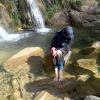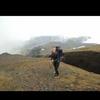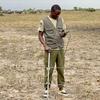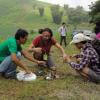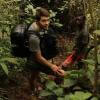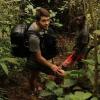Camera traps have been a key part of the conservation toolkit for decades. Remotely triggered video or still cameras allow researchers and managers to monitor cryptic species, survey populations, and support enforcement responses by documenting illegal activities. Increasingly, machine learning is being implemented to automate the processing of data generated by camera traps.
A recent study published showed that, despite being well-established and widely used tools in conservation, progress in the development of camera traps has plateaued since the emergence of the modern model in the mid-2000s, leaving users struggling with many of the same issues they faced a decade ago. That manufacturer ratings have not improved over time, despite technological advancements, demonstrates the need for a new generation of innovative conservation camera traps. Join this group and explore existing efforts, established needs, and what next-generation camera traps might look like - including the integration of AI for data processing through initiatives like Wildlife Insights and Wild Me.
Group Highlights:
Our past Tech Tutors seasons featured multiple episodes for experienced and new camera trappers. How Do I Repair My Camera Traps? featured WILDLABS members Laure Joanny, Alistair Stewart, and Rob Appleby and featured many troubleshooting and DIY resources for common issues.
For camera trap users looking to incorporate machine learning into the data analysis process, Sara Beery's How do I get started using machine learning for my camera traps? is an incredible resource discussing the user-friendly tool MegaDetector.
And for those who are new to camera trapping, Marcella Kelly's How do I choose the right camera trap(s) based on interests, goals, and species? will help you make important decisions based on factors like species, environment, power, durability, and more.
Finally, for an in-depth conversation on camera trap hardware and software, check out the Camera Traps Virtual Meetup featuring Sara Beery, Roland Kays, and Sam Seccombe.
And while you're here, be sure to stop by the camera trap community's collaborative troubleshooting data bank, where we're compiling common problems with the goal of creating a consistent place to exchange tips and tricks!
Header photo: Stephanie O'Donnell
No showcases have been added to this group yet.
- @Muzna
- | She, Her
Muzna Kashaf is a dedicated herpetologist who recently achieved her MPhil, showcasing her commitment to advancing knowledge in the field. Her research focus lies in amphibians, and she has utilized Geographic Information Systems (GIS) to enhance precision of her studies.

- 0 Resources
- 6 Discussions
- 2 Groups
- 0 Resources
- 6 Discussions
- 3 Groups
Panthera

- 0 Resources
- 2 Discussions
- 1 Groups
- @lucytallents
- | She/Her
VerdantLearn
Sociable e-learning for conservation capacity building

- 4 Resources
- 6 Discussions
- 4 Groups
- 0 Resources
- 0 Discussions
- 3 Groups
- @CitlalliMJ6
- | she/her
Conservation biologist, executive director at the Tesoro Escondido Reserve Foundation in the Ecuadorian Chocó, working on participatory action research, environmental education, primate and amphibian conservation
- 0 Resources
- 0 Discussions
- 7 Groups
St. Lawrence University
Professor of Biology at St. Lawrence University
- 0 Resources
- 2 Discussions
- 12 Groups
- @diego_lizcano
- | He/Him
Wildlife biologist interested in biodiversity monitoring and the conservation of mammals. Passionate photographer.
- 0 Resources
- 0 Discussions
- 7 Groups
wildlife crime WWF-NL
- 0 Resources
- 2 Discussions
- 6 Groups


- 0 Resources
- 33 Discussions
- 3 Groups
- 0 Resources
- 0 Discussions
- 16 Groups
- @jenlaw
- | She/Her
Biodiversity scientist specialising specialising in the study of tropical ecosystems and their biodiversity using multiple forms of technology, including acoustics, images and robotics.
- 0 Resources
- 0 Discussions
- 14 Groups
Did someone read/know this book?
9 February 2025
The worst thing a new conservation technology can do is become another maintenance burden on already stretched field teams. This meant Instant Detect 2.0 had to work perfectly from day 1. In this update, Sam Seccombe...
28 January 2025
This leads to an exciting blog we did recently, it also includes a spatial map indicating elephant movement tracks of an orphaned elephant who self released himself into the wild (Kafue National Park). Cartography was...
28 January 2025
The Zoological Society of London's Instant Detect 2.0 is the world's first affordable satellite connected camera trap system designed by conservationists, for conservationists. In this update, Sam Seccombe describes the...
21 January 2025
The Department of Wildlife, Fish, and Environmental Studies (WFE), SLU, Umeå, is looking for a postdoc with strong interests in wildlife conservation technology.
15 January 2025
Article
SPARROW: Solar-Powered Acoustics and Remote Recording Observation Watch
18 December 2024
The Department of Wildlife, Fish, and Environmental Studies (WFE), SLU, Umeå, is looking for a postdoc with strong interests in wildlife conservation technology. She/he will work within Big Picture, a European project...
18 December 2024
Fully funded 2 year position within a Biodiversa+ funded project
16 December 2024
Interesting webinar on the use of advanced technologies(e.g. Artificial Intelligence, cloud computing, drones, camera traps and satellites) for biodiversity monitoring in the Amazon. Also available in Spanish.
25 November 2024
Are you stuck on an AI or ML challenge in your conservation work? Apply now for the chance to receive tailored expert advice from data scientists! The deadline for applications is Monday 9 December 2024.
13 November 2024
Managing large volumes of camera trap data can be time-consuming and labor-intensive, especially when it comes to detecting and classifying wildlife. To tackle these challenges, Declas v1.0.0 has been released—an open-...
30 September 2024
August 2025
event
event
September 2025
event
event
event
February 2023
58 Products
Recently updated products
4 Products
Recently updated products
| Description | Activity | Replies | Groups | Updated |
|---|---|---|---|---|
| Hi Ștefan! In my current case, I am trying to detect and count Arctic fox pups. Unfortunately, Arctic fox does not seem to be included in the training data of SpeciesNet but... |
+16
|
AI for Conservation, Camera Traps | 3 months 1 week ago | |
| Interesting. Thanks for the explanation. Nice to hear your passion showing through. |
|
AI for Conservation, Camera Traps, Data management and processing tools, Open Source Solutions, Software Development | 3 months 2 weeks ago | |
| Weeks with continuous inference would require a pretty big battery. I expect you would need some kind of customisation and maybe quite a bit of compromise to last weeks and on a... |
|
Camera Traps | 3 months 2 weeks ago | |
| 📸 Do you use camera traps in your work? Take part in our survey!Hi everyone! I’m currently a final-year engineering... |
|
Camera Traps, AI for Conservation, Data management and processing tools, Open Source Solutions, Software Development | 3 months 2 weeks ago | |
| That's great! |
|
Camera Traps | 3 months 3 weeks ago | |
| Yes, I know about this big limitation,As far as I know they are working to increase the coverage available for this solution.For trusted developers, there are more regions... |
|
Connectivity, Camera Traps | 3 months 4 weeks ago | |
| Hi, just wanted to let whoever is interested that v.1.3 of DeepFaune is out! Deepfaune is a software that runs on any standard... |
|
Camera Traps, AI for Conservation, Open Source Solutions | 3 months 4 weeks ago | |
| Hi there I am looking into the feasibility of a remote camera program in the Yukon Territory, Canada outside of cellular coverage with the... |
|
Camera Traps | 4 months ago | |
| [Full disclosure: this question was also posted to the AI for Conservation Slack, and I'm copying and pasting my answer from there to here.]The first thing I would recommend is... |
|
Camera Traps | 4 months ago | |
| Using some cheap WiFi router (brand Comfast) which has a USB port where I connected a USB SSD drive 1GB. I have flashed it with OpenWRT, rebuilt ffmpeg (as ffmpeg-custom) to... |
+26
|
Camera Traps | 4 months 2 weeks ago | |
| Hi @rcz133 thanks for the update it looks promissing! An external motion PIR as @EDsteve develloped could help reduce the power consumption related to the video pipeline, but so... |
+10
|
Camera Traps | 4 months 2 weeks ago | |
| Training remains somewhat more of a hassle than inference, but thanks to a WILDLABS grant, our friendly neighborhood machine learning folks at DrivenData are working to narrow... |
|
Camera Traps | 4 months 2 weeks ago |

